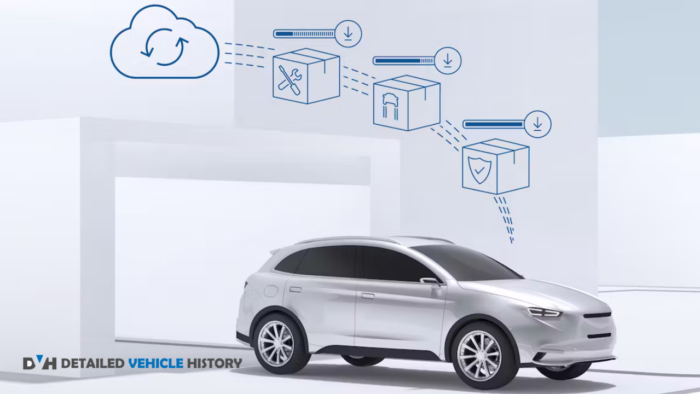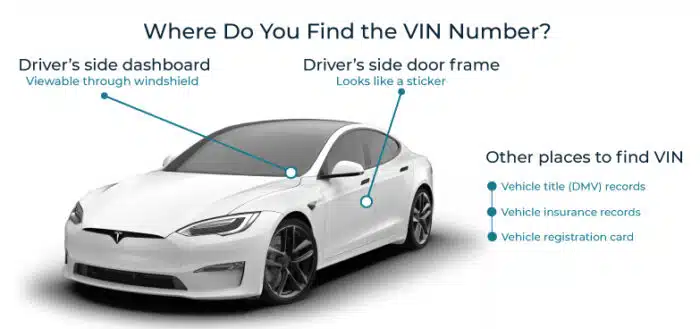When considering the purchase of a vehicle, understanding its options and safety features is paramount.
The Vehicle Identification Number (VIN), a 17-digit unique code assigned during production, plays a crucial role in this process. It provides insights into the manufacturer, production location, and the car’s specific options and packages. Assessing a car’s options is vital for ensuring it aligns with your needs and preferences.
To enhance the understanding of a car’s specifications when buying a car, the National Highway Traffic Safety Administration (NHTSA) offers a free VIN check tool for decoding VIN numbers. However, this tool doesn’t reveal the options and packages available for a particular vehicle.
So let’s take a ride to find out how to look up your VIN for the vehicle specs and all the available options and packages.
What Are Vehicle Options?
Vehicle options encompass a range of features, configurations, and accessories available when purchasing a vehicle. When choosing options, consider preferences, needs, and budget.
Common options include:
- Trim Levels: Offer varying features, performance, and luxury. Higher trims come with more advanced features.
- Engine Options: Provide choices with different power, fuel efficiency, and performance levels.
- Transmission: Manual or automatic, with variations like CVT (Continuously Variable Transmission) or DCT (Dual-Clutch Transmission).
- Drive Configuration: Options for Front-Wheel Drive (FWD), Rear-wheel Drive (RWD), or All-Wheel Drive (AWD).
- Interior Materials: Choices for upholstery and color schemes, often premium in higher trims.
- Technology Packages: Group advanced tech features like infotainment, navigation, and driver-assistance systems.
- Safety Features: Additional safety options like adaptive cruise control and lane-keeping assist.
- Wheels and Tires: Options for sizes and types.
- Exterior Colors: Different color choices.
- Sunroof/Moonroof: Option for added openness.
- Towing Package: Available for SUVs and trucks, including a hitch and cooling features.
- Performance Packages: Offer enhanced suspension, brakes, etc., for sports vehicles.
When exploring options during car shopping, it’s crucial to view them as manufacturer-installed add-ons that enhance the vehicle’s functionality, aesthetics, or performance.

How to Look Up Vehicle Options by VIN Number: Step by Step Guide
Follow these simple steps to decode a vehicle’s VIN and look up the vehicle options from Detailed Vehicle History:
- Navigate to the website header.
- For basic option lookup, click “VIN Decoder” from the products and services drop-down.
- For advance option lookup, click “window sticker by VIN” instead. This usually requires a small fee to access full vehicle options.
- Enter or scan the VIN number and provide other required information like your email address and phone number.
View and verify basic information about the vehicle for free. This includes the specifications, engine configuration, drive type and more.
For detailed information about the vehicle’s safety features, standard features, colors and more, please opt for the window sticker by VIN.
Differentiating Between Vehicle Options, Packages and Accessories
Distinguishing between these three terminologies is vital in understanding a car’s customization.
Options refer to individual add-ons, like a touchscreen or a specific engine.
Packages, such as BMW’s Dynamic Handling Package, bundle related options for a cohesive result, like improved handling. Notably, packages may be exclusive to certain trim levels.
On the other hand, accessories are post-purchase add-ons, like floor mats or a wireless charging pad, enhancing the car’s aesthetics or functionality.
Each element plays a distinct role in tailoring the vehicle to the buyer’s preferences, with packages often ensuring a harmonious combination of features for optimal performance.
How Vehicle Options Affect Trim Level
First let’s understand what a trim level is.
A car trim level signifies the set of features a vehicle has, ranging from basic to advanced packages. It’s a key identifier for car buyers, reflecting the car’s specifications and price. Commonly referred to as “style,” trim levels vary by manufacturer and may denote body styles like coupe or sedan.
Manufacturers typically offer four to five trim levels per model, with the base model as the starting point, progressing in features and cost as you move up. Examples include basic, mid-range, and premium trims, each offering varying levels of complexity and specifications.
The vehicle options affect the trim level in the following ways:
- Vehicle options significantly impact the trim level by determining the set of features available for a particular model. Some packages, like the Brembo brake and Recaro seat package in the Mazda Miata, are exclusive to specific trim levels.
- The inclusion or exclusion of certain options can define a trim’s characteristics, influencing factors like handling, safety enhancements, or visual aesthetics.
- When considering a car, understanding how options align with trim levels ensures that buyers choose a configuration that meets their desired specifications, whether it’s for performance, safety features, or aesthetic preferences.
The interplay between options and trim levels creates an accurate selection process for buyers seeking a tailored automotive experience.
To accurately access a vehicle’s standard options, factory installed packages and accessories in one place, turn to our window sticker by VIN lookup tool for quick results.
Vehicle Options Breakdown: A 2019 BMW 2 Series As A Case Study
Here’s a quick breakdown of the options available for a 2019 BMW 2 SERIES M2401 as provided in the window sticker generated using the VIN number (WBA2N1C55KVC28492).
CATEGORY | OPTIONS |
Colors |
|
Lights |
|
Seats |
|
Doors, Windows and Mirrors |
|
Body and Appearance |
|
Steering Wheel |
|
Engine and Transmission |
|
Drive Type |
|
Safety Features |
|
Security |
|
Cooling Systems |
|
Performance Package |
|
Technology Package |
|
Indicators and Sensors |
|
Infotainment |
|
Other Accessories |
|
Effortlessly use our universal Window Sticker Lookup Tool by VIN to instantly look up all vehicle options for any vehicle model.
The Importance of VIN (Vehicle Identification Number) In Vehicle Option Lookup
Finding the VIN Number
A car VIN can typically be found in the following places:
How to Decode a VIN Number?
Decoding a VIN number involves using a tool which helps in interpreting the information contained in the VIN. This enables individuals to access detailed vehicle specifications based on its VIN.
For more, you can read our guide on how to decode a Ford VIN number. This method is the same for decoding VINs from other vehicle brands.
Why is it Important to Decode Your VIN?
Decoding your VIN holds significant importance, particularly when making preowned car purchases or managing the maintenance and safety of a vehicle.
Ensuring Accurate Vehicle Information for Used Car Purchases
By decoding the VIN, individuals can ensure that the information provided about a used vehicle is accurate and corresponds to the vehicle in question. This is essential for making informed purchasing decisions.
Identifying Recalls and Safety Concerns through VIN Lookups
VIN lookups help in identifying any recalls or safety concerns associated with a particular vehicle. This is critical for understanding potential issues and ensuring the safety of the vehicle’s operation.
Accessing Vehicle-Specific Information for Maintenance and Repairs
Decoding the VIN provides valuable insights into the vehicle’s specifications, enabling individuals to access specific information for maintenance and repairs. This includes identifying compatible parts and understanding the vehicle’s technical requirements.
VIN Decoder Tools: Free VIN Decoder vs. Paid Options
VIN decoder tools are readily available online and can provide comprehensive information about a vehicle. By providing the VIN, users can access data such as the vehicle’s manufacturing details, including its model, engine type, and transmission specifications.
While there are free VIN decoder options available, paid services may offer more extensive reports with additional information about the vehicle’s history.
The choice between free and paid options depends on the level of detail required. However, if you’re buying a preowned car, a paid option or VIN check is usually recommended.
If you’re seeking comprehensive details like used vehicle history, running a VIN check on third party sites like Detailed Vehicle History website before buying a used car can provide extensive records, offering insights into the vehicle’s past, current status, and even likely future maintenance needs beyond what a free VIN check may provide.
Importance of VIN in Vehicle History Search
Conclusion
Every car has its own unique VIN and it encodes information about the vehicle’s specific options and can be used to gain access into the vehicle’s history and condition. This information is crucial to both new and used car buyers in making an informed buying decision, negotiating a fair price with sellers, thus leading to an overall better experience with their purchase. Need to decode or check a VIN for the vehicle specifications, options, packages and even history (in case of a used car)? Get started with our services today!Need to check a Vehicle history without the VIN? Don’t worry. Conduct a License Plate Lookup instead (US Plates Only).
Frequently Asked Questions
Can I see what options my car has by VIN?
Yes, you can view the options your car has by using the VIN. The Vehicle Identification Number (VIN) contains information about the car’s manufacturer, production location, and specific options.
How do I find a build sheet by VIN number?
To find a build sheet by VIN number, visit the Detailed Vehicle History site and select “Classic Car Build Sheet” to get started. You can also contact the car manufacturer or use online resources that offer VIN decoding services. These services may provide detailed information about your vehicle’s build, including its specifications and features.
Can I use my VIN number to find parts?
Yes, you can use your VIN number to find parts. By providing the VIN to auto parts suppliers or using online databases like Detailed Vehicle History, you can identify the specific components and accessories compatible with your vehicle.
Can I check vehicle recalls by my car's VIN?
Yes, you can check vehicle recalls by entering your car’s VIN. The National Highway Traffic Safety Administration (NHTSA) also provides a free VIN check tool that allows you to check for recalls and obtain information about any safety issues associated with your vehicle.

